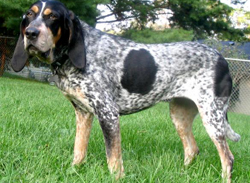Bluetick Coonhounds are lean, compact, medium-sized dogs with short, dense, glossy coats. These dogs have a distinctive mottled black and white coat that creates a dark blue look. Their eyes are large and round, and their thin ears hang and are set low. They have a large nose. Bluetick Coonhounds measure 21 to 27 inches at the shoulder and weigh 45 to 80 pounds. With proper care, this breed lives up to 14 years.
A naturally protective and alert breed, Bluetick Coonhounds make excellent watchdogs. They are reserved with strangers but non-aggressive. They can have fun goofing around with their family, but they don't always enjoy being the center of attention.
These dogs make easygoing, playful, and protective companions, and they are perfectly suited for families with children. They also require very little grooming, although they have a musty odor that some people dislike.
The Bluetick Coonhound breed gets its name from its coat, which looks dark blue with a mottled, or "ticking," pattern.
Bluetick Coonhounds are gentle, playful, and affectionate dogs that love cuddling on the couch and sleeping in bed with their human family. They are adaptable animals that thrive in both apartments and houses with yards, and they get along very well with children. They are also good with other dogs and with cats, provided they are raised with them.
A naturally protective and alert breed, Bluetick Coonhounds make excellent watchdogs. They are reserved with strangers but non-aggressive. They can have fun goofing around with their family, but they don't always enjoy being the center of attention. In fact, some Bluetick Coonhounds are a little bashful.
These dogs have high exercise needs and benefit from a couple of long walks every day. They also like to go for a run on occasion, and they should be offered some time in a large, enclosed space a few times each week. To relax, Bluetick Coonhounds enjoy car rides and hanging out around the house. Without sufficient mental and physical stimulation, they dogs may bawl loudly and disturb neighbors.
A relatively healthy breed, Bluetick Coonhounds are not at risk for many serious diseases. However, it's always important to research a puppy's family line before purchase or adoption. Hip dysplasia, eye problems, and hypothyroidism are more common in these dogs than in some other breeds, and Bluetick Coonhounds are at increased risk for lysosomal storage diseases, which are inherited metabolic disorders. These dogs are also prone to ear infections due to having floppy ears.
These dogs are also at risk for bloat, a condition that causes a distended abdomen, weakness, shortness of breath, rapid heartbeat, nonproductive retching, excessive salivation, pale gums, lowered body temperature, and collapse. Without treatment, bloat may progress to gastric torsion, which is potentially fatal.
Bluetick Coonhounds can live 12 to 14 years with good nutrition, regular exercise, and routine veterinary care.
A highly intelligent breed, Bluetick Coonhounds learn quickly. These dogs are easy to train provided commands are consistent and firm and training methods are positive and fun. They do not respond well to harshness or negativity. They may goof around or act silly during training, and it's important not to laugh at them if this occurs; giving them any sort of attention in response to this behavior will only reinforce it.
Bluetick Coonhounds are happiest when given a job to do, no matter how small. They are especially fond of hunting, but will find amusement and purpose in most tasks. Anything that challenges them mentally as well as physically is a good choice, as they dogs are naturally curious and are superior problem solvers.
Although they are usually well behaved, Bluetick Coonhounds can be loud and stubborn and have a tendency to stick their nose into any food or drink left out. They also can't resist the urge to run after an interesting smell, and they must be kept on a leash for their own protection. Training can help resolve some of these negative behaviors.
Bluetick Coonhounds are low-maintenance dogs that require very little grooming. A weekly brushing with a rubber curry brush or hound mitt is usually enough to keep their coat clean and shiny. Regular brushings will help control dead hair and keep it off furniture and clothing, but these dogs are not normally prone to excessive shedding.
People with an aversion to doggy odor may not appreciate the Bluetick Coonhound's musty scent. Regular baths will help reduce the odor, but there's no way to get rid of it completely. If the breed's odor is not a problem, bathing is only necessary to remove sticky or harmful substances from the coat.
The nails should be trimmed every few weeks, or as needed, and the ears need to be cleaned, dried, and checked every week for wax accumulation and signs of infection. Redness, odor, discharge, and other indications of a bacterial or fungal ear infection require prompt attention by a veterinarian. The teeth need brushing regularly to reduce the risk of periodontal disease and tooth decay.
The Bluetick Coonhound breed originated in America several centuries ago. It was developed by crossing the English Foxhound, Grand Bleu de Gascogne, and other European hounds with American hounds to combine the instincts and nose of Old World dogs with the speed and endurance of hounds in the United States.
These dogs were referred to as English Coonhounds for many years in the US, but in 1945, breeders of the Bluetick dogs broke away from English breeders to maintain their own breed, which was a little slower. Bluetick Coonhounds excel at hunting raccoons and other small game.
The American Kennel Club officially recognized the Bluetick Coonhound in 2009.

